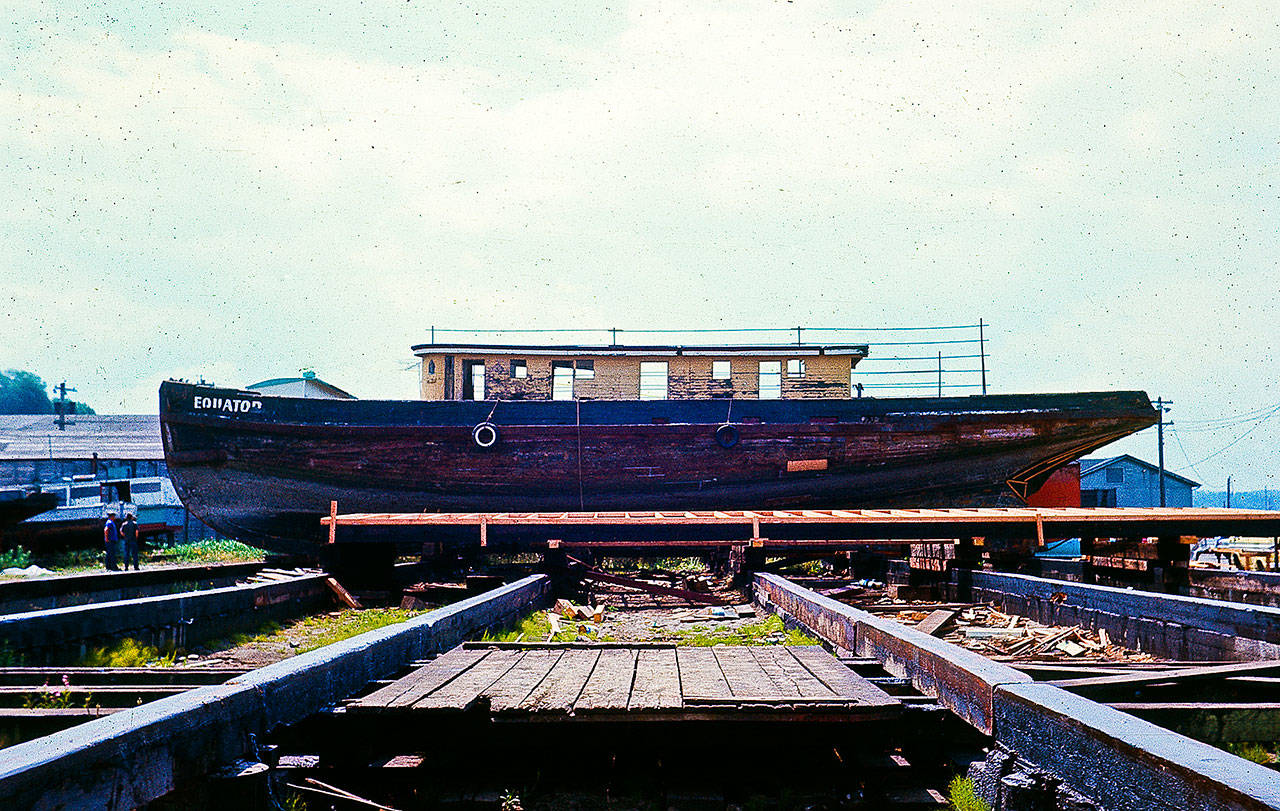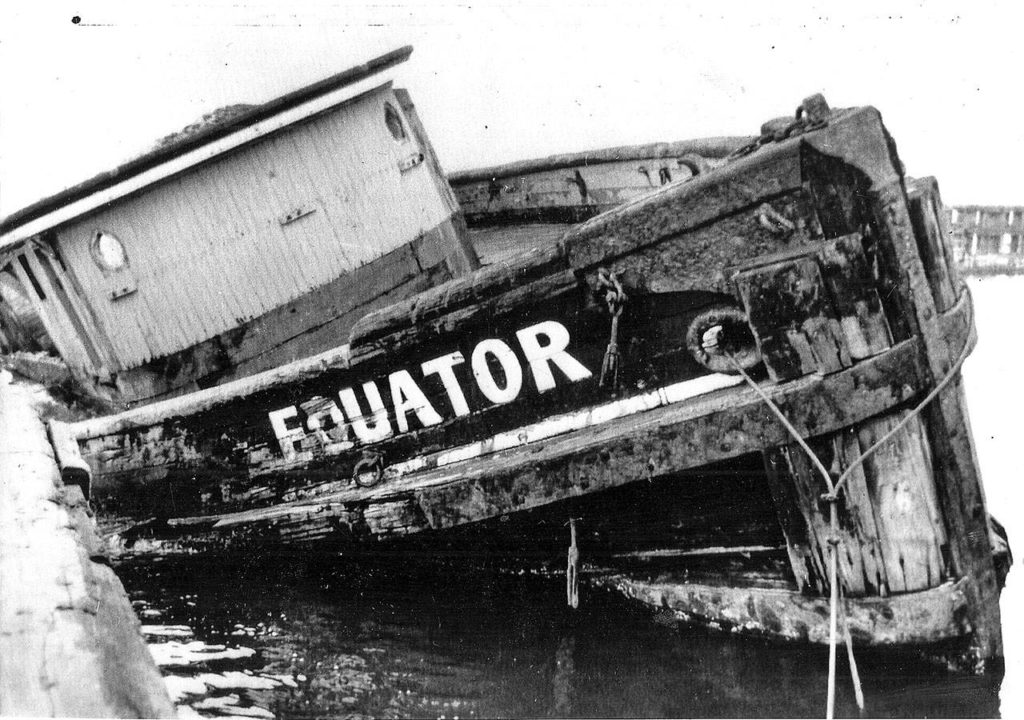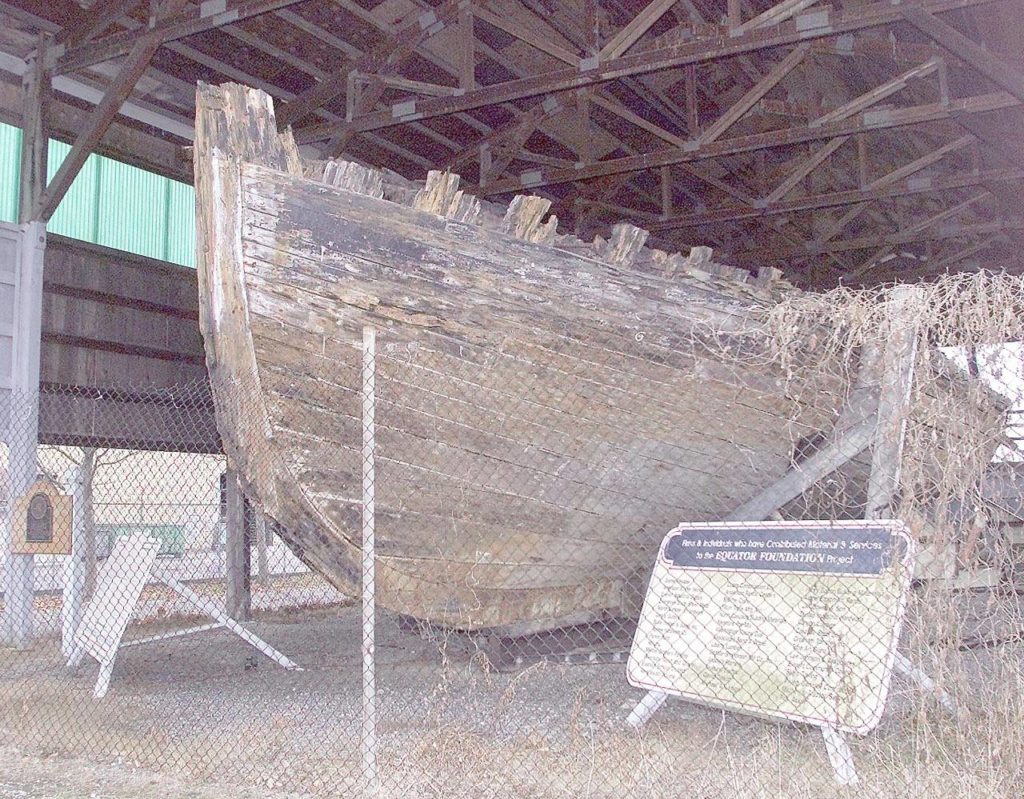It was built for trade, but the schooner Equator knew glamour, too: It embarked on a South Seas cruise just a year after it was launched, with one of the biggest celebrities of the 19th century on board.
The 78-foot vessel endured a hard-knock life after that. It was converted to a steam- and later diesel-powered workboat, ridden hard in the logging and fish canning industries, and finally put away wet on the Everett waterfront in the 1950s.
A community group formed a foundation and rescued the hulk, and through their efforts the Equator became the first artifact in Snohomish County to be added to the National Historical Registry.
But the foundation could not raise the money needed to restore the vessel.
The latest indignity for the Equator happened in November, when its aft 10-12 feet broke off. The Equator has sat under a roof since the 1980s, but the shed near the 10th Street Boat Launch is open on all four sides, and the elements have taken a toll.
“It’s decaying badly,” said Lisa Lefeber, the Port of Everett’s acting CEO and executive director. The broken-off bits of the stern remain under the shed, she said.
Before its backbone broke, the vessel’s remains were documented by marine archaeologists Katie Custer and Piotr Bojakowski, then of Texas A&M University. The scientists visited Everett twice to take extensive photos and obtain a sample of its timbers.
Why all the fuss over a boat skeleton?
For one, the Equator is said to be the last schooner of its kind in North America. It was built for the South Seas copra trade (copra is dried coconut).
But there’s a more exotic angle to the Equator’s story.
That tale begins in 1889, about a year after the Equator was built in Benicia, California, and dispatched to the South Seas, where it soon rode out a cyclone that destroyed two American warships.
The Scottish writer Robert Louis Stevenson, one of the most famous authors in the world during his lifetime, chartered the vessel for the second of three South Seas cruises he made in the late 1880s and early ’90s, along with his free-spirited wife Fanny, who was 10 years his senior. Stevenson, who paid $5,000 (about $140,000 in today’s money) for the six-month charter, wrote about his voyages aboard the Equator in “In the South Seas.”
The lank-haired Stevenson, best known for “Strange Case of Dr. Jekyll and Mister Hyde,” “Kidnapped” and “Treasure Island,” suffered from chronic lung disease and hoped to regain his health in Polynesia. His hopes were unrealized; Stevenson died in 1894 in Samoa, probably of a cerebral hemorrhage. (Fanny Stevenson apparently fancied younger men, because years after her husband’s death, she took up with a writer who was 38 years her junior.)
The Equator’s celebrity provenance apparently did not impress its later owners. The vessel was shorn of its two-masted schooner rig, subjected to an ungainly cabin superstructure and converted to steam power in the early 20th century. It was put to work hauling fish and logs up and down the Pacific coast. In 1923, it ran aground on the Quillayute River bar off the Olympic Peninsula and filled with sand.
The vessel was patched up, refloated and put back to work, getting a new diesel power plant in 1940. By 1956, its well-built wooden hull was finally clapped out, and the Equator was abandoned on Jetty Island.
Thanks in large part to enthusiasm over the Stevenson connection, the boat was dug off the jetty and moved to what’s now known as Marina Village on 14th Street in the mid-1960s. A Kiwanis Club group led by Eldon Schalke, an Everett dentist, formed a foundation and tried to raise funds to restore the vessel. Their efforts fell short, but the Equator did get added to the historical registry in 1972 — despite the fact that it had nothing to do with Everett aside from being abandoned there to rot.
“It’s interesting that people got behind it,” said Everett resident Jack O’Donnell, who has chronicled local history for years. “It was audacious to think that they’d get it floating.”
Backers hoped, in vain, that inclusion on the registry would kick-start money for the Equator’s restoration, O’Donnell said. The foundation dissolved after Schalke’s death, in a plane crash, in 1992.
By the late 1980s, the crumbling boat was not fitting in with the new restaurants and hotels at Marina Village, so the Port of Everett moved it to its current home on 10th Street. Dick Eitel, the longtime owner of Fisherman’s Boathouse on the waterfront, built the shed it sits under, O’Donnell said.
The Equator sits on land that was purchased with federal funds under an arrangement that restricts its use to recreational activities, so there’s no chance of condos displacing the old schooner, the port’s Lefeber said.
“We’re working on enclosing all three sides to protect it from the elements,” she said. “If it continues to decay, maybe there’s an opportunity to get it to the (Everett Museum of History).”
But if the Equator is moved, only a piece of it, perhaps the bow section, will go. The boat would surely collapse into a pile of splinters and dust if an attempt were made to move all that’s left of it, Lefeber said.
Another complication is that the Equator is an orphan, with no legal owner. Since the foundation that was set up to restore it ceased to exist long ago, “we would have to go through a legal proceeding before we could do anything,” Lefeber said.
Your hometown’s history
This story is part of an occasional series on buildings, homes, parks, etc. in Snohomish County that have been named to local, state and national lists of historic places.
Talk to us
> Give us your news tips.
> Send us a letter to the editor.
> More Herald contact information.




























